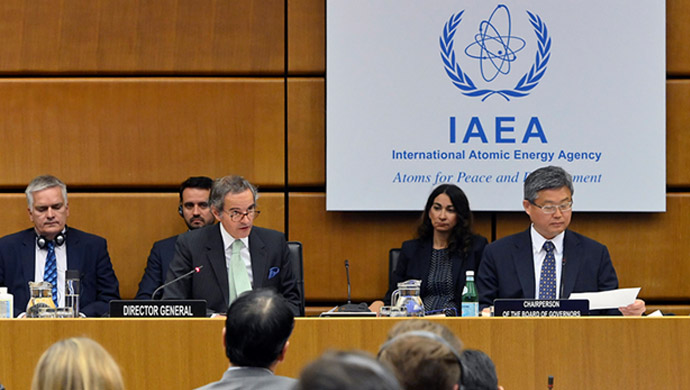The United States, France, Germany, and the United Kingdom have issued a draft resolution to the Board of Governors of the International Atomic Energy Agency (IAEA), the United Nations nuclear watchdog, emphasizing the imperative for the Iranian regime to respond to the IAEA’s outstanding questions regarding its suspect nuclear activities.
This resolution will most likely be adopted by the Board despite opposition from Russia and China, according to media reports citing diplomats. The text cites the IAEA’s outstanding questions and ambiguities regarding the regime’s controversial nuclear program, and specifically names three sites that the mullahs had not declared and where the IAEA detected traces of uranium particles. The resolution also raises concerns about Tehran’s ongoing refusal to fully cooperate with the UN nuclear watchdog.
For nearly 18 months Iran’s regime has been resorting to various deceptive measures to prevent an IAEA resolution from being tabled and adopted. Whenever the IAEA reported Tehran’s refusal to cooperate and the Board of Governors was on the verge of issuing a report, with just days left the mullahs’ would invite IAEA chief Rafael Grossi to Tehran, provide an insignificant concession along with pledges to cooperate, and kick the can down the road for another three months until the Board of Governors would meet again; making this entire cycle repeating itself all over again. This time around, however, despite all of Tehran’s threats and brouhaha, the U.S. and three European powers are going forward with the draft resolution.
Of course, this text falls short of referring the Iranian regime’s nuclear dossier to the UN Security Council. Therefore, would adopting such a text cause meaningful concerns for Tehran?
IAEA DG Rafael Grossi said #Iran’s regime had failed to reduce concerns about violations of its nonproliferation safeguards agreement, will eventually cross the uranium enrichment threshold. #IAEA’s Board of Governors is to decide on decades of denial, deception & duplicity. pic.twitter.com/KAjGQpZtdc
— Alireza Jafarzadeh (@A_Jafarzadeh) June 7, 2022
Although the resolution appears to be a mere warning, it does indicate the West considering a new approach. Previously, the policy had consisted of engaging with Tehran and providing concessions while allowing the mullahs to continue with their deceptive tactics. This draft resolution, however, indicates that the West has significantly lost hope in reaching a nuclear agreement with the regime and has a taken step, albeit small, towards adopting a firm policy vis-à-vis Tehran.
From another perspective, one can safely describe this resolution as the first step in a path leading to the regime’s nuclear dossier once again being referred to the UN Security Council and reviewed under Chapter 7 of the UN Charter. The reasoning behind such logic is simple: if Tehran refuses to respond to the IAEA’s questions and cooperate with the agency, the next Board of Governor’s meeting in September will be yet another step towards referring the mullahs’ nuclear file to the UN Security Council.
As a result, Tehran is currently faced with three options:
- a) The regime, concerned about the substantial consequences of its nuclear dossier being once again referred to the UN Security Council, capitulates and agrees to cooperate with the IAEA. Considering the fact that the most important step in cooperating with the IAEA is answering the agency’s questions regarding the possible military dimensions of its nuclear drive, Tehran has to take the lid off all its secret nuclear activities. This specifically includes indicating the origin of illicit uranium particles found at three different sites and why were these locations kept off limits to the IAEA? In such a scenario, it will become obvious that Tehran has been secretly seeking nuclear weapons, which will lead to a UN Security Council referral and the resulting heavy consequential measures.
- b) Tehran decides to continue its confrontation with the IAEA and the international community. In such a case, its nuclear dossier will be referred to the UN Security Council in the coming months, which can result in more U.S. sanctions and a return of similar European Union restrictions.
- c) The mullahs decide to continue their deceptive measures. However, considering the past 18 months of cat-and-mouse games and resorting to various tactics to buy time, if such an initiative was plausible Tehran would have adopted the necessary measures to prevent a draft resolution being introduced to the IAEA Board of Governors in the first place.
There are those who believe the status quo was inevitable, and even obvious, when Iranian regime Supreme Leader Ali Khamenei made his decision last year to have Ebrahim Raisi, known for his decades-long role as a mass executioner, installed as president. Raisi was brought to confront an increasingly restive Iranian population. It would be illogical, some argue, to think Raisi would be willing to cooperate with the IAEA and the international community.
Although the possible adoption of the IAEA Board of Governors’ resolution may only deliver a mere warning to the Iranian regime, it is ushering Tehran into a complicated path of troubling ups and downs. Time will tell.





